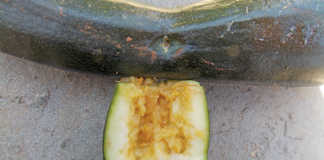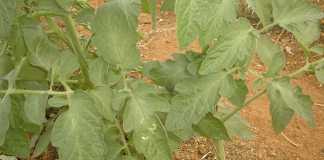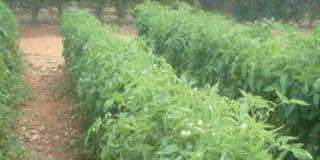This virus is one of two that affects this crop family. The other one is turnip mosaic virus, but CaMV is much more prevalent. Despite this, many farmers are ignorant about CaMV and when they see a lighter-coloured cabbage among the rest – which is one of CaMV’s symptoms – they dismiss it as an “off-type” without considering that it may be diseased. However, CaMV does tend to manifest symptoms more clearly on certain varieties than on others, and the symptoms also show up much more clearly in winter than in summer.
How it spreads
CaMV is spread by aphids. As there can be thousands of aphids on a single plant, there is the potential for a colony of aphids on one infected plant to cause extensive damage. Many systemic insecticides give the plant’s sap an unpleasant taste, so when an aphid alights and probes the plant as a potential food source, it may not be to it’s liking. It will try the next one, and so on. In the process, many plants can become infected by a single aphid.
The aphid eventually dies – but the damage has been done. I saw evidence of this in six plants in close proximity, which were all infected in the middle of a relatively clean land by one infected aphid. The aphid doesn’t even have to be of a cabbage-colonising species to do damage. There is a species that I can’t yet identify, which is shiny and develops an orangy colour. These are a pest in Brussels sprouts, and don’t colonise cabbages, even though a cabbage land may be adjoining a heavily infected Brussels sprout land.
However, I found that they do spread CaMV from the Brussels sprouts to the cabbages. Even though they don’t colonise cabbages, they spread the virus as they taste them. Plants infected with this virus have a lighter colour and if a leaf is held up to the sun, you’ll see a mosaic marbling effect on it.
Just as Aids makes humans susceptible to other diseases, so too CaMV makes plants susceptible to downy mildew, which starts on the older, lower leaves. Farmers are often advised to spray for downy mildew. They see the mildew, but don’t recognise the underlying virus. Many farmers may not know about the connection between downy mildew and CaMV, but if a single plant develops downy mildew, you can be sure that it has the virus too.
Stopping the virus
The best remedy, of course, is to limit aphid numbers. A few aphids won’t do too much damage, provided there’s no virus present. This is why it’s so important to be able to identify CaMV. Farmers in close proximity should work together too, as aphids don’t recognise boundaries.
On one occasion many years ago, a whole district was seriously infected, so much so that it was difficult to find a healthy cabbage. Farmers there had to be educated about the virus, so that they didn’t unwittingly enable it to spread. You have to be careful not to have any aphids on infected plants.
If you come across the odd virus-infected plant with an aphid population, it’s worthwhile removing the plant and burying it, as it’s difficult to control all the aphids – some may be inside the plant, unaffected by the insecticide. Don’t take any chances with CaMV, as it isn’t a disease to be taken lightly, especially in the cool months when aphids are more active. Rather be safe than sorry!
Bill Kerr (016 366 0616 or e-mail [email protected]).













